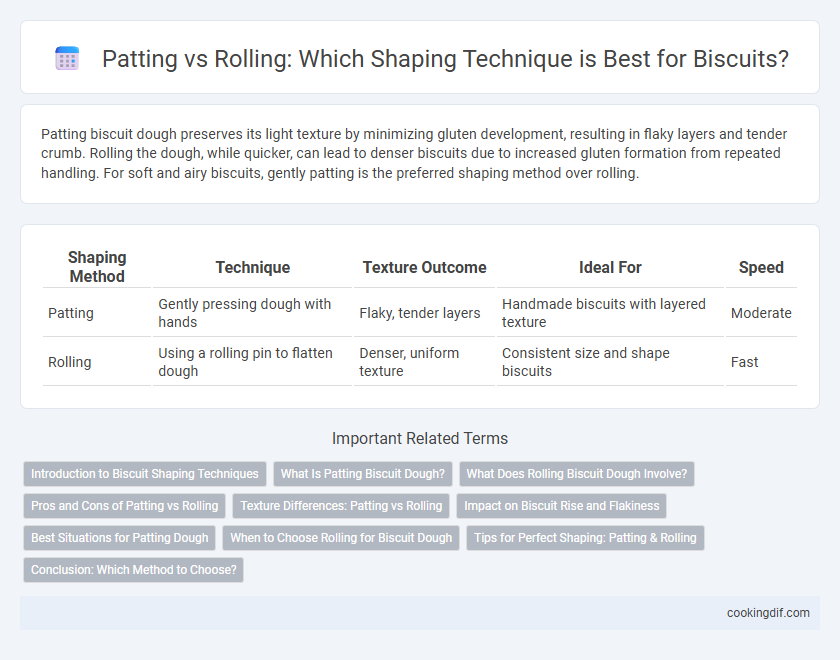Patting biscuit dough preserves its light texture by minimizing gluten development, resulting in flaky layers and tender crumb. Rolling the dough, while quicker, can lead to denser biscuits due to increased gluten formation from repeated handling. For soft and airy biscuits, gently patting is the preferred shaping method over rolling.
Table of Comparison
| Shaping Method | Technique | Texture Outcome | Ideal For | Speed |
|---|---|---|---|---|
| Patting | Gently pressing dough with hands | Flaky, tender layers | Handmade biscuits with layered texture | Moderate |
| Rolling | Using a rolling pin to flatten dough | Denser, uniform texture | Consistent size and shape biscuits | Fast |
Introduction to Biscuit Shaping Techniques
Patting biscuit dough creates a denser texture by gently pressing it into shape, preserving the dough's layers and preventing overworking. Rolling the dough evenly with a pin ensures consistent thickness, which promotes uniform baking and a tender crumb. Mastering both patting and rolling techniques allows bakers to control biscuit flakiness and rise effectively.
What Is Patting Biscuit Dough?
Patting biscuit dough involves gently pressing the dough down with hands to achieve the desired thickness without overworking it, which helps maintain its tender texture. Unlike rolling, patting minimizes gluten development, resulting in flakier, softer biscuits with a delicate crumb. This technique is essential for preserving the dough's lightness and ensuring a tender, flaky consistency after baking.
What Does Rolling Biscuit Dough Involve?
Rolling biscuit dough involves using a rolling pin to flatten the dough to an even thickness, which allows for uniform baking and consistent texture throughout. This method compresses the dough slightly, resulting in tighter layers that can make the biscuits denser and less flaky. In contrast to patting, rolling is best suited for achieving precise thickness and smooth surfaces, though it may reduce the dough's rise during baking.
Pros and Cons of Patting vs Rolling
Patting biscuit dough preserves its flaky layers by minimizing gluten development, resulting in a tender, flaky texture, but may produce less uniform thickness. Rolling provides even thickness and consistent shape, ideal for uniform baking, but can overwork the dough, leading to tougher biscuits due to gluten activation. Choosing patting maintains delicate layers, while rolling offers precision and uniformity in biscuit shaping.
Texture Differences: Patting vs Rolling
Patting biscuit dough creates a flaky, tender texture by gently pressing without overworking the gluten, resulting in layers that rise distinctly during baking. Rolling biscuit dough tends to develop a denser, chewier crumb because the repeated motion can activate gluten strands, reducing overall lightness. Choosing patting over rolling preserves the biscuit's intended delicate, airy structure essential for optimal texture.
Impact on Biscuit Rise and Flakiness
Patting biscuit dough preserves the layers of butter, resulting in superior flakiness and a higher rise due to trapped steam during baking. Rolling the dough can compress these layers, leading to a denser texture and reduced lift. For optimal biscuit rise and flaky texture, patting is the preferred shaping technique.
Best Situations for Patting Dough
Patting dough is ideal for biscuits when aiming to maintain a tender, flaky texture by avoiding overworking the dough and preserving air pockets. This method works best for sticky or delicate doughs that are difficult to roll out without tearing or compressing. Using a gentle patting technique ensures consistent thickness, preventing dense or tough biscuits especially in recipes with high butter content.
When to Choose Rolling for Biscuit Dough
Rolling biscuit dough is ideal when aiming for uniform thickness and consistent shape, ensuring even baking and a flaky texture. This method is preferred for thinner biscuits or when using biscuit cutters to create precise rounds or shapes. Patting dough works better for thicker, rustic biscuits where a tender, crumbly texture is desired.
Tips for Perfect Shaping: Patting & Rolling
For perfect biscuit shaping, patting the dough gently with your hands helps retain its flaky layers by avoiding overworking the gluten. Rolling should be done with light, even pressure using a floured rolling pin to maintain dough thickness and prevent sticking. Resting the shaped biscuits in the refrigerator before baking enhances rise and texture by solidifying fats.
Conclusion: Which Method to Choose?
Patting biscuits creates a denser, flakier texture by gently pressing the dough, preserving layers without overworking it. Rolling tends to produce more uniform thickness but risks compressing the dough, resulting in tougher biscuits. For tender, flaky biscuits, patting is the preferred method to maintain lightness and delicate layers.
Patting vs rolling for shaping Infographic

 cookingdif.com
cookingdif.com